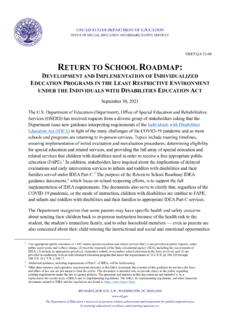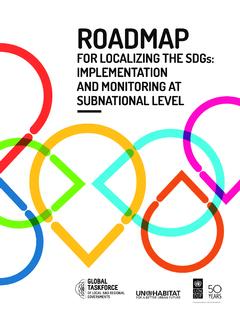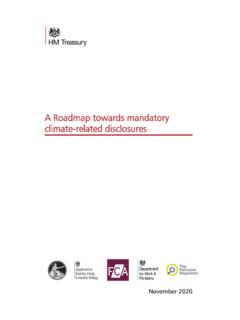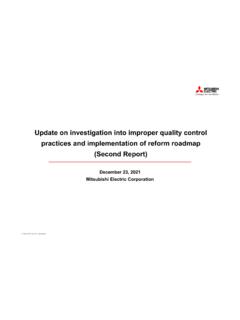Transcription of National Internet of Things (IoT) Strategic Roadmap: A …
1 National Internet of Things (IoT) Strategic roadmap : A SummaryNational Internet of Things (IoT) Strategic roadmap : A Summaryan initiative byNational IoT Strategic roadmap : A SummaryFirst Publication: 2015 MIMOS BerhadAll rights reserved. No part of this publication may be reproduced, stored in a retrieval system or transmitted in any form or by any means, electronic, mechanical, photocopying, recording or otherwise without the prior permission of the by:MIMOS BERHAD Technology Park Malaysia 57000 Kuala Lumpur, MALAYSIATel: +60 3 8995 5000 & +60 3 8995 5150 Fax: +60 3 8996 2755 Berhad@mimosmalaysiaMIMOS Malaysiain alignment with1 National IoT Strategic roadmap : A Summary contentsNATIONAL IOT Strategic roadmap : AN 21. WHY Internet OF Things (IOT)?.. 4a. Internet of Things b. Megatrends 2. WHERE WE 6a. Global Market Potential b.
2 Malaysia Market Potential c. Readiness of Malaysia for IoT 3. WHAT WE WANT TO 10a. Vision b. Mission c. Goals 4. implementation 11a. Short-Term Strategies b. Long-Term Strategies 5. WAY 14 APPENDIX: PILOT 15 National IOT Strategic roadmap : A SUMMARY2 National IoT Strategic roadmap : A Summary3 National IoT Strategic roadmap : A Summary 4 National IoT Strategic roadmap : A SummaryA. Internet OF Things The Internet of Things (IoT) is a convergence of smart devices that generate data through sensors to create new information and knowledge to boost human intelligence, efficacy and productivity to enhance the quality of is defined as Intelligent interactivity between human and Things to exchange information and knowledge for new value creation . It is a complex yet complete solution encompassing three main technology components namely connected Things with embedded sensors, connectivity and infrastructure, and most importantly analytics and applications (refer to Figure 1).
3 1. Why Internet of Things (IoT)?Figure 1: Components of IoTIntegration & Collaborative InformationKnowledge for Action & FeedbackDataConnectivity& InfrastructureConnected ThingsAnalytics & AppsStaticDynamicCloud Data ProtectionData ProcessingStorageDomain KnowledgeApps & ServicesConnectivity5 National IoT Strategic roadmap : A Summary Figure 2: Megatrends resulting in IoTB. MEGATRENDSIoT technology is resultant from major megatrends: (i) Market and (ii) Technology as depicted in Figure 2. As a result, the implication of these two megatrends will force global society to implement new technology in order to enhance productivity, optimise resources and increase sharing efficiency while maintaining individual in demand structureDecision making & actionPersonalisation & high involvementOn-demandOptimisationCollabor ation & innovationShared information & powerRichness of informationDemographic ShiftBig DataIndividual EmpowermentCloud Computing Food, Energy & Water NexusSocial MediaDiffusion of Power Proliferation of Things Ageing society Urbanisation & migration Rise of women power Insights & knowledge generation Growth of global middle class Higher education level Delivery of information & functionality to anyone.
4 Anytime & anywhere Competitive demand for scarce natural resources Constant interconnectivity & sharing of information Highly connected & networked society Granular & multidimension data collectionInternet of Things6 National IoT Strategic roadmap : A SummaryA. GLOBAL MARKET POTENTIALIoT opportunities are enormous with a global economic value projection ranging from US$ trillion to US$ trillion by 2020. There is strong momentum for the prevalence of IoT solution implementation across the world where several countries started to embark on IoT projects that focus on energy, water, transport, building management, and government service delivery (refer to Figure 3).2. Where We AreFigure 3 : Global IoT implementationsChina: Started in 2005 Traffic systems & IoT 2011: Food safety & healthcare in remote & rural areasAustralia: Started in 2010 Renewable energy & electric vehicles Healthcare, government & infrastructureKorea: Started in 2003 Smart city & smart government 2014: 5G network technology (intelligent networks)South Africa: Started in 2010 IoTEG (IoT Egineering Group), CSIR Meraka Applications: Connected devices, energy efficiency, enabling smart environmentsSingapore: Started in 2013 Areas: Wireless technology, smart products & smart nationIndia: Started in 2010 Areas: Water, energy & waste resource efficiencies, environmental governanceEurope & Japan: Started in 2013 ClouT: Joint European-Japanese ICT project for smart citiesUSA: Started in 2010.
5 SmartAmerica Areas: Manufacturing, healthcare, energy, transportation & disaster response, government, aeronautics & social mediaEurope: Started in 2011 Smart Cities & Community Cognitive IoT Smart objects Smart transportationRussia: 2020 target: US$980M Vehicles, smart parking, smart cities payment terminals, devices and sensorsCanada: Started in 2010: i-CANADA Healthcare, TeleWork, e-commerce, education & government Public Sector Smart CityJapan: Started in 2010 Home energy management: Yokohama city, Kansai Science City & Kitakyushu city Transport: Toyota City Applications: Vending machines, transportation management, surveillance & e-wallet services7 National IoT Strategic roadmap : A Summary B. MALAYSIA MARKET POTENTIALThe initial IoT economic potential for Malaysia will be billion GNI creation by 2020 and it is expected to experience exponential growth beyond 2020 and reach billion (refer to Figure 4).
6 Technology opportunities can be created by IoT in Malaysia with forecast technology opportunities for: Application and services amounting to RM34 billion in 2025 compared to billion for 2020 Device producers at billion and billion for years 2020 and 2025 respectivelyGlobal ScenarioMalaysia Scenario 202020202025 Layer 5: AnalyticsRM890 Billion% of IoTLayer 4: Apps & Services80% 3: Computing & StorageRM61 Billion5% 2: Communications & NetworkingRM58 Billion 5% 1: Things : Hardware, Power & ProtocolsRM105 Billion10% 4: IoT technology opportunitiesSource: Gartner (2014)8 National IoT Strategic roadmap : A SummaryBesides delivering financial impact to the nation, IoT can serve as a good platform for the research community to commercialise R&D outputs. As of 2012, there are 146 potential patents from Malaysia inventors which can be licensed to investors to enhance the competitiveness of their IoT applications and services.
7 Furthermore, the growth of IoT in the Malaysian market is projected to generate a total of 14,270 high-skilled employment opportunities by will be the transformative and pervasive driver of change and improvement by potentially adding new dimensions to the industry in the following ways: Testing facilities for interoperability, standards compliance and export-related testing Software development standardisation to address standard silos and facilitate the creation of niche applications and services System integration services to produce experts from entrepreneurs through interaction with various stakeholders in the ecosystemC. READINESS OF MALAYSIA FOR IOTM alaysia has an encouraging environment and a strong starting point to foster and spur IoT within the domestic market due to the following: High mobile penetration at percent and observation of multiple handset ownership percent of Malaysians are Internet users with 59 percent being active users Social media penetration in Malaysia is at 45 percent Domestic ICT consumption is projected at billion in 2015 and will register billion by 2020 with a CAGR of percentWhile acknowledging the advantages of IoT technologies, several challenges must be addressed to unleash the full potential of IoT besides leveraging on existing strengths for IoT (refer to Table 1) to continue to open new markets and drive new applications and opportunities for a wide spectrum of IoT Strategic roadmap .
8 A Summary FactorStrengthsWeaknessesTechnology Well-established mobile operators and five operators licensed to provide 3G services Technology complexity Legacy systems Security and privacy concerns Data accessibility and knowledge sharing availabilityResource Creation of new MSC cybercities and cybercentres SMEs as source of endogenous growth and innovation E&E industry is leading in terms of investment, industrial output, value add, exports and employment Fragmented funding instruments unable to generate required impact Barriers to free market competition existSocietal High phone and Internet penetration rates Sophisticated consumers are eager to use mobile data and value-added services Rural adoption and adaptation fear - technology phobiaPolitical Various incentives like pioneer status, tax exemptions and allowances to promote ICT investment Intellectual property protection and cyberlaws Dedicated performance management entity exists to monitor and drive performance of innovation initiatives Broken linkages across industry and public RIs Multiple public agencies working in silos on innovation initiativesTable1: Readiness of Malaysia in exploring IoT opportunities10 National IoT Strategic roadmap : A SummaryA.
9 VISION Malaysia to be the Premier Regional IoT Development HubB. MISSION To create a National IoT ecosystem to enable the proliferation of use and industrialisation of IoT as a new source of economic growthC. GOALS The goals of the National IoT Strategic roadmap are to integrate all efforts from various stakeholders in Malaysia to focus on areas of identified significant value creation through three Strategic goals:GOAL 1: Create a conducive IoT industry ecosystem to foster the development, diffusion and adoption of IoT technologies with the following strategies: To formulate an interoperability framework that harmonises the heterogeneity and complexity of standards and technologies To institute a centralised regulatory and certification body to address privacy, security, quality and standardisation concerns To establish Strategic collaborations between MNCs and local players GOAL 2.
10 Strengthen technopreneur capabilities and foster the generation of globally-competitive IoT products and services to further strengthen Malaysia s position in the IoT industryGOAL 3: Malaysia as the Regional Development Hub for IoT; with the establishment of an integrated centre for IoT solutions, equipped with supporting services and facilities such as interoperability testing and development of IoT products and services, Malaysia will be positioned as the preferred location for IoT outsourcing services for the Malaysian industry and the world at large3. What We Want to Achieve11 National IoT Strategic roadmap : A Summary 4. implementation StrategiesGoalStrategyShort-Term Initiative(2015-2017)Mid-Term Initiative(2018-2020)Long-Term Initiative (Beyond 2020)1. Create a conducive IoT industry ecosystemEnhance the regulatory framework to cater for IoT technologies Strengthen institutional support in areas of technology and standards development Leverage on existing initiatives and infrastructure to facilitate the creation of the IoT industry 2.







